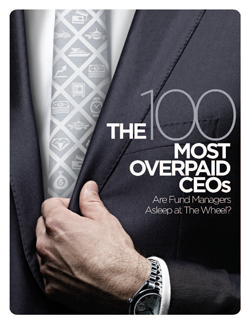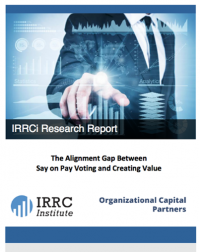Over 300:1. That’s the ratio of CEO to employee pay in the United States. The U.S. leads the world in excessive executive compensation, to the detriment of shareholders. The current system of executive pay distorts incentives, exacerbates income inequality, and leads consumers and employees to think the game is rigged against them.
The Top 100 Most Overpaid CEOs: Are Fund Managers Asleep at the Wheel?
Download the most recent report now!
CEO pay grew an astounding 943% over 35 years, from 1978-2015, vastly outpacing growth in the cost of living, the productivity of the economy, and the stock market.
The third report in the series, The 100 Most Overpaid CEOs: Are Fund Managers Asleep at the Wheel? highlights the forces behind disproportionate pay and the fund managers who continue to approve these pay packages.
Visit our blog
CEO Pay Updates: 2017 Proxy Season
Sign up for email alerts to keep updated on skyrocketing CEO pay throughout the proxy season
As You Sow will soon release the second annual edition of our groundbreaking report, The 100 Most Overpaid CEOs, which examines the trends and forces behind ever-increasing executive compensation. With the 2016 proxy season soon approaching, our new blog will offer updates on the pay of some of the companies featured in our report.
Visit ceopay.asyousow.org to read the blog and sign up for email alerts, or follow us on Twitter for in-the-moment updates as proxy materials are released.
Take Action
Read the 2016 report
The 100 Most Overpaid CEOs: Executive Compensation at S&P 500 Companies
CEO pay grew an astounding 997% the past 36 years, vastly outpacing growth in the cost of living, the productivity of the economy, and the stock market.
The second report in the series, The 100 Most Overpaid CEOs: Are Fund Managers Asleep at the Wheel? highlights the forces behind disproportionate pay and the fund managers who continue to approve these pay packages.
To learn about the 100 most overpaid CEOs, the compensation committee members recommending the pay packages, and the mutual funds rubber-stamping excessive CEO pay, download the full 2016 report.
Read the 2015 report
The 100 Most Overpaid CEOs: Executive Compensation at S&P 500 Companies
CEO pay has grown nearly 1,000% over the past four decades, far exceeding growth in median worker pay or company share prices. Our new report, The 100 Most Overpaid CEOs: Executive Compensation at S&P 500 Companies, highlights the 100 most overpaid CEOs and examines the forces behind the trend of ever-increasing CEO pay.
Skyrocketing CEO pay packages represent a misallocation of assets that is detrimental to investors, and a driver of wider social inequality. Using a methodology that combines statistical analysis and an in-depth examination of over 30 ‘red flag’ indicators, the report found widespread consensus on the worst actors, companies with huge pay packages that showed relatively weak shareholder returns.
To learn about the 100 most overpaid CEOs, the compensation committee members recommending the pay packages, and the mutual funds rubber-stamping excessive CEO pay, download the full report.
Background
As You Sow’s Executive Compensation initiative encourages shareholders to use the Power of the Proxy to better control and reduce unjustified CEO pay and to create greater equity in compensation across all publicly traded US companies. Our goal is to help shareholders, including mutual funds, pensions, foundation, endowments, and individuals to create proactive change in a broken system. The initiative will be:

- Engaging shareholders and helping them hold money managers accountable for their votes;
- Pushing companies to develop new social and environmental performance criteria, and working with them to do so;
- Identifying the most overpaid executives, the money managers that approved the compensation plans, the consultants that proposed them, and the compensation committee board directors that approved their compensation packages;
- Encouraging foundations and public funds to adopt stringent voting guidelines to address specific disconnects between pay and performance, as well as the systemic issues that drive the increases, such as peer group selection and inflationary ratcheting up of compensation.
From 1978 to 2013, CEO compensation, inflation-adjusted, increased 937 percent, a rise more than double stock market growth and substantially greater than the painfully slow 10.2 percent growth in a typical worker’s compensation over the same period.
– EPI: CEO Pay Continues to Rise as Typical Workers are Paid Less
In 2014, the median pay for CEOs crossed $10 million dollars. The current system of executive pay:
- Contributes to the destabilizing effects of income inequality;
- Makes investors, consumers and employees wonder if they are playing in a game rigged against them;
- Distorts incentives, leading to a short-term focus rather than sustainable growth for companies.
A recent poll showed that only 18% of Americans think the pay of top corporate executives is appropriate. Yet for the most part, shareholder advisory votes (which are required under corporate reform) give rubber-stamp approval to astronomical executive compensation packages, with average support of over 90 percent.
For more background on executive compensation, read our FAQs.

New report finds institutional investors and proxy advisors fail to use economic value creation as a major factor in Say-on-Pay voting
A new report from IRRC Institute finds that institutional investors and proxy advisors fail to use economic value creation as a major factor in Say-on-Pay voting. The research analyzed the most recent Say-on-Pay votes for more than 100 institutional investors with approximately $13 trillion in total global assets under management at a sample of 128 S&P 1500 companies.












